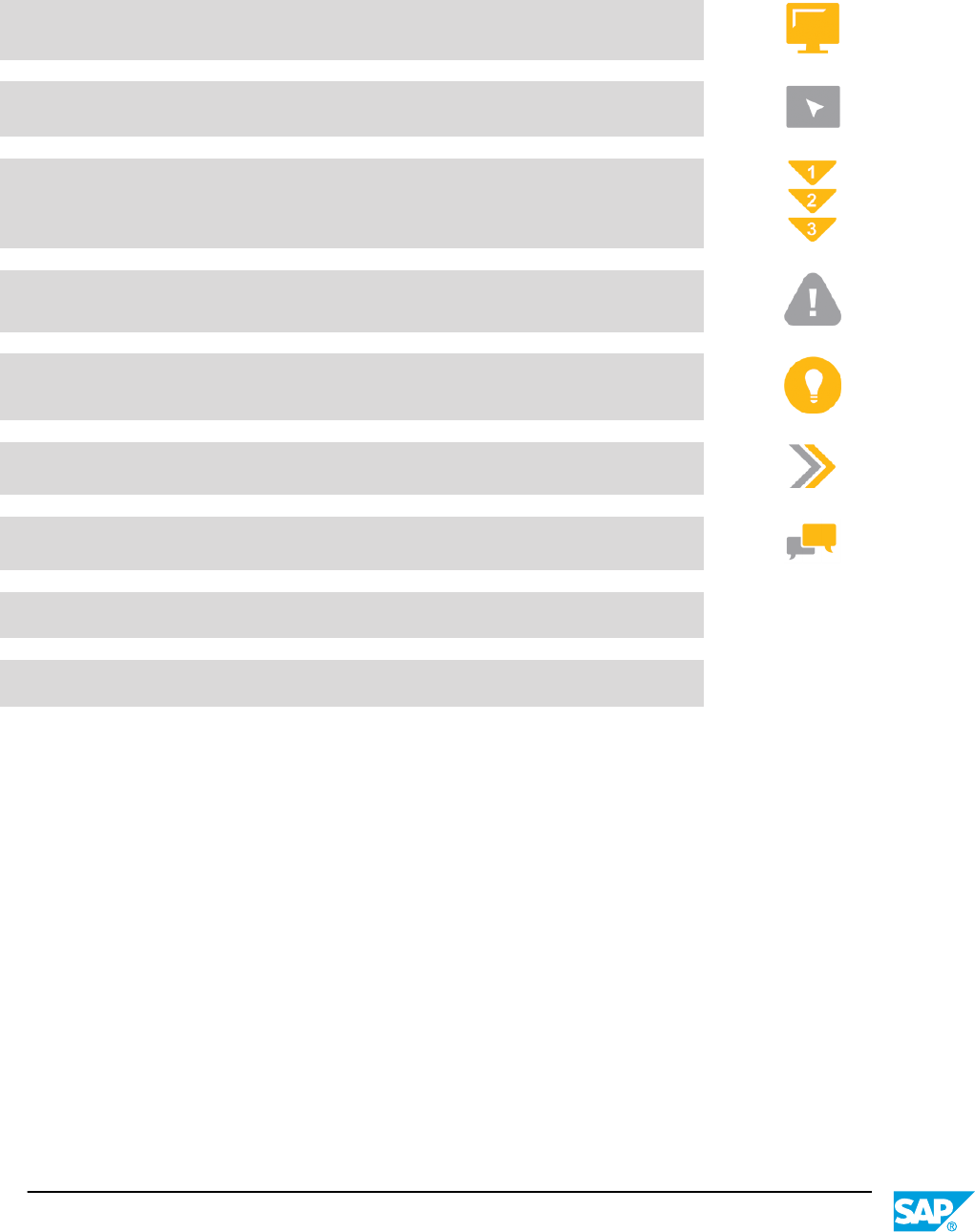
CA710
Report Writer
.
.
COURSE OUTLINE
.
Course Version: 15
Course Duration: 3 Day(s)
SAP Copyrights and Trademarks
©
2014 SAP AG. All rights reserved.
No part of this publication may be reproduced or transmitted in any form or for any purpose
without the express permission of SAP AG. The information contained herein may be
changed without prior notice.
Some software products marketed by SAP AG and its distributors contain proprietary
software components of other software vendors.
●
Microsoft, Windows, Excel, Outlook, and PowerPoint are registered trademarks of
Microsoft Corporation.
●
IBM, DB2, DB2 Universal Database, System i, System i5, System p, System p5, System
x, System z, System z10, System z9, z10, z9, iSeries, pSeries, xSeries, zSeries, eServer,
z/VM, z/OS, i5/OS, S/390, OS/390, OS/400, AS/400, S/390 Parallel Enterprise
Server, PowerVM, Power Architecture, POWER6+, POWER6, POWER5+, POWER5,
POWER, OpenPower, PowerPC, BatchPipes, BladeCenter, System Storage, GPFS,
HACMP, RETAIN, DB2 Connect, RACF, Redbooks, OS/2, Parallel Sysplex, MVS/ESA,
AIX, Intelligent Miner, WebSphere, Netfinity, Tivoli and Informix are trademarks or
registered trademarks of IBM Corporation.
●
Linux is the registered trademark of Linus Torvalds in the U.S. and other countries.
●
Adobe, the Adobe logo, Acrobat, PostScript, and Reader are either trademarks or
registered trademarks of Adobe Systems Incorporated in the United States and/or
other countries.
●
Oracle is a registered trademark of Oracle Corporation
●
UNIX, X/Open, OSF/1, and Motif are registered trademarks of the Open Group.
●
Citrix, ICA, Program Neighborhood, MetaFrame, WinFrame, VideoFrame, and MultiWin
are trademarks or registered trademarks of Citrix Systems, Inc.
●
HTML, XML, XHTML and W3C are trademarks or registered trademarks of W3C®, World
Wide Web Consortium, Massachusetts Institute of Technology.
●
Java is a registered trademark of Sun Microsystems, Inc.
●
JavaScript is a registered trademark of Sun Microsystems, Inc., used under license for
technology invented and implemented by Netscape.
●
SAP, R/3, SAP NetWeaver, Duet, PartnerEdge, ByDesign, SAP BusinessObjects
Explorer, StreamWork, and other SAP products and services mentioned herein as well
as their respective logos are trademarks or registered trademarks of SAP AG in
Germany and other countries.
●
Business Objects and the Business Objects logo, BusinessObjects, Crystal Reports,
Crystal Decisions, Web Intelligence, Xcelsius, and other Business Objects products and
services mentioned herein as well as their respective logos are trademarks or
registered trademarks of Business Objects Software Ltd. Business Objects is an SAP
company.
●
Sybase and Adaptive Server, iAnywhere, Sybase 365, SQL Anywhere, and other Sybase
products and services mentioned herein as well as their respective logos are
trademarks or registered trademarks of Sybase, Inc. Sybase is an SAP company.

All other product and service names mentioned are the trademarks of their respective
companies. Data contained in this document serves informational purposes only. National
product specifications may vary.
These materials are subject to change without notice. These materials are provided by SAP AG
and its affiliated companies ("SAP Group") for informational purposes only, without
representation or warranty of any kind, and SAP Group shall not be liable for errors or
omissions with respect to the materials. The only warranties for SAP Group products and
services are those that are set forth in the express warranty statements accompanying such
products and services, if any. Nothing herein should be construed as constituting an additional
warranty.
© Copyright . All rights reserved. iii

iv © Copyright . All rights reserved.

Typographic Conventions
American English is the standard used in this handbook.
The following typographic conventions are also used.
This information is displayed in the instructor’s presentation
Demonstration
Procedure
Warning or Caution
Hint
Related or Additional Information
Facilitated Discussion
User interface control Example text
Window title Example text
© Copyright . All rights reserved. v

vi © Copyright . All rights reserved.

Contents
ix Course Overview
1 Unit 1: Report Writer Components
1 Lesson: Identifying the Components of the Report Writer
1 Lesson: Configuring Report Writer Libraries and Directories
3 Unit 2: Report Writer
3 Lesson: Comparing Report Writer to Report Painter
5 Unit 3: Report Writer Sets
5 Lesson: Creating Basic Sets
5 Lesson: Creating Single Sets
5 Lesson: Creating Key Figure Sets
5 Lesson: Creating Multisets
5 Lesson: Using Sets in Report Writer Reports
5 Lesson: Using Sets Across Applications
7 Unit 4: Report Variables
7 Lesson: Defining Basic Variables
7 Lesson: Defining Formula Variables
7 Lesson: Using Variables in Reports
7 Lesson: Adding Text to Reports
9 Unit 5: Sets in Report Writer Reports
9 Lesson: Using Sets in Reports
11 Unit 6: Report Formatting
11 Lesson: Applying Total Levels
11 Lesson: Applying Suppression
11 Lesson: Setting Page Breaks in Reports
11 Lesson: Using Standard Layouts and Format Groups
13 Unit 7: Sections
13 Lesson: Using Sections in Reports
13 Lesson: Using Section Layouts and Attributes
13 Lesson: Using Row and Column Blocks
13 Lesson: Using Row Block Attributes
13 Lesson: Dividing and Joining Sections
© Copyright . All rights reserved. vii

15 Unit 8: Cells and Key Figure Blocks
15 Lesson: Using Cells to Perform Calculations
15 Lesson: Defining and Using Global Cells
15 Lesson: Calculating Key Figures
15 Lesson: Building Reports with Calculated Key Figure Blocks
17 Unit 9: Key Figures
17 Lesson: Creating Key Figures
17 Lesson: Using New Key Figures
viii © Copyright . All rights reserved.

Course Overview
TARGET AUDIENCE
This course is intended for the following audiences:
●
Application Consultant
●
Technology Consultant
© Copyright . All rights reserved. ix

x © Copyright . All rights reserved.

UNIT 1 Report Writer Components
Lesson 1: Identifying the Components of the Report Writer
Lesson Objectives
After completing this lesson, you will be able to:
●
Identify the reporting tools available in the SAP system
Lesson 2: Configuring Report Writer Libraries and Directories
Lesson Objectives
After completing this lesson, you will be able to:
●
Configure the Report Writer components
© Copyright . All rights reserved. 1

Unit 1: Report Writer Components
2 © Copyright . All rights reserved.

UNIT 2 Report Writer
Lesson 1: Comparing Report Writer to Report Painter
Lesson Objectives
After completing this lesson, you will be able to:
●
Compare Report Writer to Report Painter functionalities
●
Convert a Report Painter report to a Report Writer report
© Copyright . All rights reserved. 3

Unit 2: Report Writer
4 © Copyright . All rights reserved.

UNIT 3 Report Writer Sets
Lesson 1: Creating Basic Sets
Lesson Objectives
After completing this lesson, you will be able to:
●
Build basic sets
Lesson 2: Creating Single Sets
Lesson Objectives
After completing this lesson, you will be able to:
●
Build single sets
Lesson 3: Creating Key Figure Sets
Lesson Objectives
After completing this lesson, you will be able to:
●
Build key figure sets
Lesson 4: Creating Multisets
Lesson Objectives
After completing this lesson, you will be able to:
●
Build multisets combining more than one set type or dimension
Lesson 5: Using Sets in Report Writer Reports
Lesson Objectives
After completing this lesson, you will be able to:
●
Construct a report using sets
Lesson 6: Using Sets Across Applications
Lesson Objectives
© Copyright . All rights reserved. 5

After completing this lesson, you will be able to:
●
Construct a Controlling report using a set from Financial Accounting
Unit 3: Report Writer Sets
6 © Copyright . All rights reserved.

UNIT 4 Report Variables
Lesson 1: Defining Basic Variables
Lesson Objectives
After completing this lesson, you will be able to:
●
Explain the purpose of value variables
●
Create a value variable
●
Create a set variable
●
Create variables for a report
Lesson 2: Defining Formula Variables
Lesson Objectives
After completing this lesson, you will be able to:
●
Create a variable to calculate input values
Lesson 3: Using Variables in Reports
Lesson Objectives
After completing this lesson, you will be able to:
●
Construct a report using variables
Lesson 4: Adding Text to Reports
Lesson Objectives
After completing this lesson, you will be able to:
●
Construct a report with text fields
© Copyright . All rights reserved. 7

Unit 4: Report Variables
8 © Copyright . All rights reserved.

UNIT 5 Sets in Report Writer Reports
Lesson 1: Using Sets in Reports
Lesson Objectives
After completing this lesson, you will be able to:
●
Use key figures in Report Painter
●
Use key figures in Report Writer
© Copyright . All rights reserved. 9

Unit 5: Sets in Report Writer Reports
10 © Copyright . All rights reserved.

UNIT 6 Report Formatting
Lesson 1: Applying Total Levels
Lesson Objectives
After completing this lesson, you will be able to:
●
Choose hierarchy levels in sets to provide report impact
●
Highlight totals in a report
Lesson 2: Applying Suppression
Lesson Objectives
After completing this lesson, you will be able to:
●
Use suppression in intervals
●
Build sets to include the suppression flag
Lesson 3: Setting Page Breaks in Reports
Lesson Objectives
After completing this lesson, you will be able to:
●
Construct a report using page breaks for impact
Lesson 4: Using Standard Layouts and Format Groups
Lesson Objectives
After completing this lesson, you will be able to:
●
Use a standard layout
●
Group report layouts and apply summation levels
© Copyright . All rights reserved. 11

Unit 6: Report Formatting
12 © Copyright . All rights reserved.

UNIT 7 Sections
Lesson 1: Using Sections in Reports
Lesson Objectives
After completing this lesson, you will be able to:
●
Construct a Report Writer report with sections
Lesson 2: Using Section Layouts and Attributes
Lesson Objectives
After completing this lesson, you will be able to:
●
Change layout setting within the report to control output
Lesson 3: Using Row and Column Blocks
Lesson Objectives
After completing this lesson, you will be able to:
●
Construct a report with unrelated data sets
●
Construct a report with calculations
Lesson 4: Using Row Block Attributes
Lesson Objectives
After completing this lesson, you will be able to:
●
Format the row blocks
Lesson 5: Dividing and Joining Sections
Lesson Objectives
After completing this lesson, you will be able to:
●
Divide and join sections to control data views
© Copyright . All rights reserved. 13

Unit 7: Sections
14 © Copyright . All rights reserved.

UNIT 8 Cells and Key Figure Blocks
Lesson 1: Using Cells to Perform Calculations
Lesson Objectives
After completing this lesson, you will be able to:
●
Build sets with symbolic names
Lesson 2: Defining and Using Global Cells
Lesson Objectives
After completing this lesson, you will be able to:
●
Construct a global cell and add it to a report
Lesson 3: Calculating Key Figures
Lesson Objectives
After completing this lesson, you will be able to:
●
Modify sets to include symbolic names for calculated key figures
Lesson 4: Building Reports with Calculated Key Figure Blocks
Lesson Objectives
After completing this lesson, you will be able to:
●
Construct a report with a calculated key figure block
© Copyright . All rights reserved. 15

Unit 8: Cells and Key Figure Blocks
16 © Copyright . All rights reserved.

UNIT 9 Key Figures
Lesson 1: Creating Key Figures
Lesson Objectives
After completing this lesson, you will be able to:
●
Build basic sets to define characteristics for key figures
Lesson 2: Using New Key Figures
Lesson Objectives
After completing this lesson, you will be able to:
●
Create a user library with key figures
●
Construct a report using the new library and key figure set
© Copyright . All rights reserved. 17
